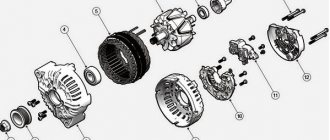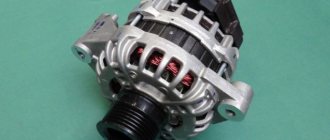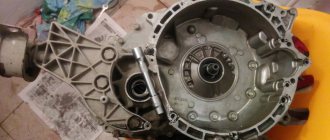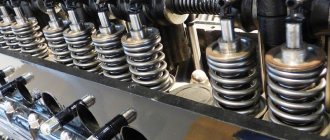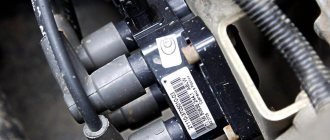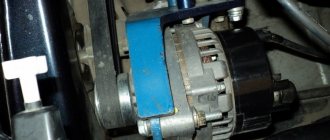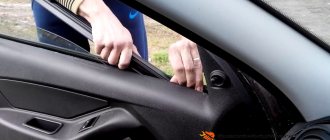The appearance of a creaking or metallic grinding sound during operation of a car engine is a sign of wear on the generator bearings on the Lada Grant. The malfunction is common on domestic cars.
The reasons for the squeaking are different: defects, violation of operating rules, damage.
Fixing the breakdown will not be difficult for the average driver. The operating principle is intuitive.
In order to provide methodological assistance to inexperienced drivers, we will consider the algorithm for replacing bearings with your own hands.
Expert answer
KZATE 115 Ampere
A 115 Ampere KZATE generator is installed from the factory. Its quality is truly below par. The diode bridges on it are lit “only on the road.” Very poor build quality.
Due to poor contact, the pad on the original generator burned out; all you had to do was tighten one bolt well
Bosch 135 Ampere
The most common replacement option is a Bosch 135 Ampere, especially since starting from 2016, all Grants are equipped with this particular model.
This is already a Bosch generator, it is what all Grants have been compiled with since 2016
The cost of a Bosch generator is about 5,000 rubles, but it is a very reliable manufacturer.
It is possible to restore an old original generator, but the master simply does not want to take on the work. This generator is made “disposable”; when disassembling it, it falls apart, and it is very difficult to roll everything back. Moreover, the wear and tear of the old “gene” could already be critical, and there the repair kit would cost like new.
Bulgarian generator 135 Ampere
I would recommend listening to the opinion of your master and purchasing a new one. I have a Bulgarian 135 Ampere generator installed, the flight is normal . When replacing, I recommend installing a bracket with a tensioner from Kalina, it is more thoughtful and convenient.
The appearance of a creaking or metallic grinding sound during operation of a car engine is a sign of wear on the generator bearings on the Lada Grant. The malfunction is common on domestic cars.
The reasons for the squeaking are different: defects, violation of operating rules, damage.
Fixing the breakdown will not be difficult for the average driver. The operating principle is intuitive.
In order to provide methodological assistance to inexperienced drivers, we will consider the algorithm for replacing bearings with your own hands.
Alternative belt replacement options
Insufficient tension creates less inconvenience than constriction. The latter provokes too rapid wear of the bearings. To avoid such a problem, many Grant owners install the tensioner themselves: a part from the Lada Kalina is perfect for this.
The manufacturer does not initially install the part at the factory, since it positions Granta as the most affordable in its class, hence the savings on components. This is typical for the cheapest models with an 8-valve power unit.
To adjust the belt tension, you can use a bracket from Kalina, modifying it a little with your own hands. To do this you will need the following set:
- bracket;
- tensioner;
- roller bracket;
- alternator belt from Kalina 1;
- screw tensioner.
Stage No. 1: dismantling the generator on the Lada Grant 8-valve
- Disconnect the terminals from the battery to prevent a short circuit in the circuit.
- We unscrew 6 bolts from under the bottom and remove the oil pan protection;
- We disconnect the rubber protective cap and unscrew the terminals from the contact board on the converter.
- The key is set to “13”, unscrew the nut of the upper fastening, and use the mounting tool to move the converter to the side. Access to the lower mount is provided.
- Unscrew and remove the lower fastening bolt.
- Using a mounting tool, we remove the generator belt from the pulleys.
- We remove the converter assembly and fix it on the surface of the workbench.
How to learn how to flash an ecu. do-it-yourself ecu flashing equipment
14.03.2021
| Go to section: Equipment for ECU firmware Key and chip programmers All equipment selected by car make and model |
Well, my dream has come true - to change my “Masquerade” to something newer and more modern. The choice fell on the VAZ 2115I 1.5L 8V - enough money for the 2006 model year. Includes HBO, music, trip computer, not very good alarm system, 14mm wheels, arch protection, sump protection and worn covers.
A list of priority work was quickly determined - a repair kit for the gas reducer and the whole range of work to put the gas equipment in order are needed. When running on gasoline, the car began to stall when the revs dropped (I’m not even talking about running on gas). The synchronizer for 2nd gear was worn out, an urgent oil and antifreeze change was required, the radiator dripped from below and a crack in the expansion tank was discovered.
A year of operation has passed and the list above has been supplemented by replacing the starter, purchasing a new mass air flow sensor, idle air regulator, installing a new alarm system with feedback, and replacing a pair of fog lights broken by stones. But no matter how hard you try, bugs still remain on the products of our automotive industry.
You could think about another car, but it’s a pity for the labor and money invested. True, replacement of parts was carried out only after repeated attempts to repair the next unit independently. I managed to do something, and if I have the opportunity, I will try to write articles on the following topics: repair and adjustment of the LPG gearbox, repair of the starter, installation of an alarm system.
Now I’ll focus on reflashing the ECU in order to teach the VAZ to drive. To begin with, I affirm that it is possible and even necessary to sew our domestic product. Moreover, a car that has not been serviced since birth, and I think there are 50 percent of these from the entire fleet of injection VAZs.
Flashing is very easy and simple - click a couple of icons on the computer, click a couple of toggle switches and it’s as if rocket fuel was poured into your car! But understanding how all this is done, combining different information into one whole is not given to everyone and is much more difficult.
New Lada: What kind of oil does AvtoVAZ fill at the Lada Grantu plant: engine and gearbox
Here is my respect for real masters! Alas, you most likely will not find ready-made information laid out on shelves anywhere. On the Internet you can piece this together by reading and re-reading numerous forums. It took me about six months before the first re-flashing with 2-3 “approaches to the projectile”.
Don’t think that writing this lengthy article was motivated by a desire to write, everything is much simpler: it’s just that during the first attempt to read the firmware from the ECU, I immediately failed - the car stopped starting! Having lost some of her nerves (it was almost at night, and in the morning she had to go to work), fortunately we managed to partially revive her - we managed to fill in the stock gasoline firmware (the gas part is still silent).
Before you start working on your own, you must:
I don’t pretend to be the ultimate truth, so I ask you not to criticize too much for the style and possible inaccuracies, but:
1. Usually there is a need for firmware - to fix obvious bugs in the factory software, to add car dynamics, or to save fuel. This is also necessary when using liquefied gas as a fuel along with gasoline. Another thing is to simply study better the structure and operation of the engine control system.
2. It is better to carry out preparation gradually. Don't try to cover everything at once. It is important to understand the principles of working with electrical and electronics, and to have good computer skills in terms of installing programs and drivers. For the rest, the Google search engine will help, you just need to formulate your queries more specifically. For example: Esud VAZ; controller connection diagram; instructions for ECU firmware;
K-Line adapter diagram; firmware; chip tuning of vases, etc. It is necessary to determine the types of ECUs and their markings, which engine needs which firmware and their designations. Deal with the immobilizer issue. When you realize that you have understood everything and decided that you have become a great specialist, do not hesitate and go to the service technician and try to discuss the virtual topic of replacing the firmware of your car and disabling (deactivating) the immo.
3. If your hands grow from the right place, then the adapter is not very difficult to assemble. The simplest one for a hardware COM port based on MAX232 and K1533LN1 and KT3102 can be found on the website Chip-tuner.ru. It will cost about a hundred even if you buy the entire package at a radio market.
For starters, he'll go. True, there is a trap here - not all system systems have a standard COM port, and even those that have it may not work. I have exactly the same motherboard - the COM port works, programs like POBEDIT (for satellite OPENs) work, but flashing programs do not work.
The shamanism with drivers and settings in the BIOS did not lead to anything. Installing new operating systems is the same without changes. Everything worked on someone else's computer. For such a case, an old data cable from a cell phone based on a PL 2303 chip and one MS L9637D can help.
The scheme works 100% (tested on January 7.2), you just need to add one line in the driver registry with parameters for non-standard ECU speeds. You will get a USB-K-Line adapter. If you add 2 more transistors and a couple of parts, you can also get an L-line. In order not to go to the market for one ms, I sacrificed the polite interior lighting and removed 9637 from the APS-4 immobilizer.
As a connector I used 2 blocks from a computer IDE cable without modifications. The cable was cut into 2 pieces of 10-15 cm each. On January 7.2 they fit well under the top and bottom of the ECU socket (empty 2 pins of the pads remain at the top or bottom of the block legs), just when reconnecting, do not confuse their location, otherwise you will burn the block.
I also used 3 microtoggle switches - common 12V, ignition " " and switching to programming mode " ". Before any operation, I turn off the 2nd and 3rd toggle switches, and turn them on in the order of 3 then 2. Sometimes I have to remove the general “ ” for a short time to receive communication. Power can be taken from the car, when working on a table “-” from an adapter with a current of about 500 mA.
4. To flash the firmware, you need the following programs: combiloader 2.18 and chiploader 1.6 (1.96 is more expanded in blocks). The first program is included in the Stp321-full kit (the loader is free and will start working when the adapter is connected). But sometimes he falls out of work or cannot complete the pouring process.
The second one works without problems. The first one is needed mainly to remove protection from the firmware you find and to install the same protection when uploading software to the ECU. It is not possible to read protected software from the controller - it is erased. Therefore, I advise you to prepare and have at least several (taken from different places) factory firmware.
After installation, the Stp321-full catalog contains a set of standard and tuning firmware, which may be suitable. You also need programs such as chipexploer 1.6 and Page 4.10 (with a tail). These programs will allow you to view the found firmware, edit, compare them with each other and assemble dual pr-ki.
On 2-core computers (and with the hyper-trading function), the tail falls off on Page. Somewhere I came across information about a patch for this problem, on single nuclear ones everything is fine. Be sure to carefully study the help for these programs and work with the firmware in them in order to understand the features and capabilities of the programs.
This way you will most likely weed out broken and questionable firmware. 2 more programs - Enigma for decoding software from the CTP standard and ICD for checking the adapter. It is better to take this entire set from the deposit (there are rarely non-working ones there). You will also get links to other resources when reading the forums.
If, after reading the article up to this point, you still have the desire to learn and move on (reflash your car), I will be very glad and wish you all success. Proceed with what you have planned, but keep in mind that all responsibility continues to fall on you. If you are not sure or are afraid, contact the specialists.
While I was writing the opus, I found gas software, built a dual petrol “gas” unit, filled it up and drove off. Made I203EL36/RB40, I203Ez36/RB40. Even with this software I felt a difference from my native EL35. I left any questions and ambiguities that arose until they were clarified.
← Diagnostics and repair of electrical systems of Mercedes and BMW of the 90s Frequent, typical faults of Peugeot →
Dismantling the generator on a Lada Grant with air conditioning
At the preparatory stage we will need the above tools and materials.
- We hang the front part of the car with a hydraulic jack, unscrew the bolts, and remove the wheels.
- In the opening of the wheel arch on the right side, unscrew the tension roller and the engine mount mount.
- Lower the jack a few centimeters lower until the converter is level with the wheel arch opening.
- We carry out the subsequent algorithm by analogy with the 8-valve modification of the engine.
Preparing the car
To fix problems with the Lada Granta generator, you will need to remove this device. Removing it has certain difficulties, but performing this procedure on your own is quite possible. In addition, dismantling has some features caused by differences in engine configuration (8 or 16 valves), as well as the presence of air conditioning.
To remove the generator from an eight-valve and sixteen-valve Granta that is not equipped with air conditioning, you will need a mounting blade and wrenches 8, 10 and 13. To carry out the same manipulation on a car equipped with air conditioning, you will need a jack, four socket wrenches (a wrench for 18), WD-40 and a wheel wrench.
Sequence of actions when replacing Lada Granta bearings
- We place the converter on the surface of the workbench, unscrew the three mounting bolts on the rectifier block (key set to “14”).
- Using a screwdriver, release the spring clamp and hold the winding with your hand.
- We bring out six winding ends.
- Unscrew the nut on the power block.
- We remove the rectifier from the generator housing.
- We use a multimeter to determine the negative diodes. To do this, connect the positive terminal of the multimeter to the negative plate. We connect one by one to the other diodes. In good condition, the diodes have a resistance value of 550 - 640 Ohms. Deviation from the norm is a sign of a malfunction.
- If the arrow tends to infinity, the diode is broken; if the needle tends to “zero,” the diode is broken.
- By analogy, we check the positive diodes, only in this case we reconnect the terminals to the “B+” terminal.
- Additionally, we check the converter housing with a multimeter for open circuits or short circuits.
- We fix the generator in a vice, unscrew the nut from the back, and remove the pulley. We first apply markers to the relative placement of the lids.
- We unscrew the four coupling bolts, pry them up with a screwdriver, and remove the generator cover.
- Remove the rotor shaft from the bearing.
Note to the driver! If necessary, use a wooden spacer to press the rotor shaft out of the bearing race. Often, during work and rotation, parts become stuck.
- We inspect the stator and its surface. In good condition, there should be no traces of the armature touching the stator. Otherwise, replace the bearings.
- Using a multimeter we check the integrity of the converter winding.
- We inspect the cover from the drive side. When rotating the axis, you will feel some play between the rings. The latter must be replaced with new ones due to wear.
- There should be no cracks on the inside of the generator cover. We replace with new ones as needed.
- Unlock the bearing and lightly hit the spacer with a hammer to press the part out of the cover seat.
- We carry out troubleshooting of parts and the converter cover. We replace components with new ones if there are signs of wear or defect.
- Use a wooden spacer to press the new bearing into the seat of the cover. Be sure to check that the winding leads do not come into contact with the converter cover.
- Check the condition of the slip rings. If there are burrs, scratches, or signs of wear, replace them with new ones.
Note to the driver! Some craftsmen practice not replacing the rings with new ones, but grinding them with sandpaper or turning them on a lathe. We remove the minimum layer of metal and then sand it with sandpaper.
- Using a tester, we check the winding resistance by applying the terminals to the slip rings. Gravity towards infinity is unacceptable, as this indicates a break in the rotor winding. The latter requires replacement.
- Finally, we check that the housing is not shorted to the rotor. The tester's arrow goes to infinity.
- Use a three-fingered puller to press out the rotor shaft bearing.
- Using a frame we press a new, serviceable bearing onto the rotor shaft. The main force is directed to the inner ring of the bearing.
- We assemble the structure in the reverse order, having previously lubricated the bearings with graphite grease. We tighten the generator cover with a force of 39-62 Nm.
Do-it-yourself replacement of generator bearings on the Lada Grant is completed.
Disassembling a Bosch washing machine
To replace bearings and seals, the Bosch machine will need to be completely disassembled. This process is very similar for different series (Bosch Classixx5, Bosh Avantixx or other) and looks like this:
- Unscrew the screws from the back of the washing machine, move it forward a little and remove the top cover.
- Remove the detergent drawer.
- Unscrew the three screws behind the cuvette and one from the inside that hold the control panel.
- Take a photo of the wiring connection, disconnect the wires, remove the panel.
- Remove the plinth panel located at the bottom of the front of the machine.
- Unscrew the screws located behind it.
- Open the hatch.
- Unclench and disconnect the clamp holding the cuff.
- Tuck the cuff inside.
- Unscrew the screws holding the UBL, stick your hand inside, pull out the locking device, disconnect the wiring and remove the part.
- Lift, remove and move the front panel to the side.
- Disconnect the compartment into which the detergent cuvette is inserted, loosen the clamp securing the hose for supplying detergent to the tank and remove the pipe.
- Unscrew the fasteners, remove the counterweights installed at the top and bottom.
- Take a photo of the heating element wiring and disconnect it.
- Unscrew the nut holding the heating element to the edge of the bolt and push it inward, then pull out the heating element.
- Substituting the container so that the remaining water does not spill onto the floor, remove the pipe going from the tank to the pump.
- Disconnect the wiring, unscrew the fasteners, remove the pressure switch.
- Remove the wiring fasteners, move the wires to the side so as not to interfere with the removal of the tank.
- Unscrew the fasteners and remove the back cover of the Bosch machine.
- Pull the belt to the side and, turning the drum, remove it.
- Unclench the clamps holding the motor wires, disconnect the wiring, unscrew the fasteners and remove the motor.
- Disconnect the pressure tap chamber.
- Unscrew the lower shock absorber mount, disconnect and remove the part.
- Holding the springs, carefully remove the tank along with the drum and pull it out of the housing.
Signs of generator malfunction, solutions
| Sign | Diagnostics, elimination |
| When the engine is running, the battery low indicator indicates | Checking the belt tension and power cable contacts. Replacement with new one |
| Rapid discharge / battery charging / boiling over | Insufficient / excessive tension of the converter belt |
| Insufficient brightness of headlights | The current in the circuit is below the minimum permissible parameter 14 - 16V. Generator dismantling, winding integrity check, repair |
| Weak sound when the engine is running | —/— |
| Increasing the brightness of the headlights when the engine speed increases | —/— |
| Engine operation is accompanied by extraneous sounds, squeaking, and metallic grinding sounds. | Bearing wear, rotor shaft defects. Dismantling, troubleshooting, replace worn bearings |
Checking and prevention
It should not be bent, its teeth should be intact. You need to inspect the seals. Leaking oil negatively affects the wear resistance of rubber. Granta users will have to listen carefully so as not to miss the moment when the alternator belt needs to be replaced. You can determine that the alternator belt will soon break: in wet weather or on a cold engine, it begins to whistle.
- dim light from headlights and dashboard;
- The interior heating is unstable;
- the sound of car horns has become lower;
- The turn signal and windshield wiper operating intervals have increased.
You can avoid regular contact with the described problem. There are several ways out for this.
Regarding the third point, some masters are not puzzled by finding a suitable option. They fix the standard fastening themselves, using a grinder and a sharpener to make it thinner. To implement the fourth option, contact a service station (also with loss of warranty) or perform all the manipulations yourself.
Review of producer prices. Catalog articles of installed bearings
| Manufacturer article number | Price, rub.) | Resource (thousand km) |
| KZATE 9402.3701-03 | ||
| Brushes 1127014022 | From 150 | 85 – 95 |
| Voltage regulator 844.3702 | From 600 | —/— |
| Diode bridge BVO4-105-01 | From 510 | —/— |
| Bearings 6303, 6203 | From 350 | —/— |
| Bosch 0 986 041 850 | ||
| Brushes 140371 | From 200 | 85 — 105 |
| Brush holder 235607 | From 250 | —/— |
| Voltage regulator IN6601 | From 1000 | —/— |
| Diode bridge INR431 | From 1500 | —/— |
| Bearings 140084, 140093 | From 200 - 300 | —/— |
| 180302 | From 250 | —/— |
| 180201 | —/— | —/— |
*prices are current as of October 31, 2018.
List of online stores providing goods (Moscow, St. Petersburg, Kyiv region)
| № | Name | Address |
| 1. | "NovaTon" | https://novaton.ua/ |
| 2. | "ZapchastKom" | https://www.zapchast.com.ua/ |
| 3. | "How much" | https://www.avtostore.spb.ru/ |
| 4. | "AutoWall" | https://www.avtoall.ru/ |
| 5. | "SV-Parts" | https://sv-parts.ru/ |
| 6. | "AvtoPiter" | https://www.autopiter.ru/ |
Reviews
| № | Positive |
| 1. | Vasily: drove over 80,000 km, no comments on the operation of the converter. At the 45,000 km mark the belt whistled, took it to a service center and had it tightened. Since then everything has worked like clockwork. |
| 2. | Gennady: I don’t complain about the car, since it’s a budget option. Breakdowns happen, but they are not so critical and can be fixed on your own. |
| 3. | Kirill: at 50,000 km I replaced the converter belt, the old one was defective. There are no comments on the other units. I made no investments except for the purchase of consumables and filters. |
| 4. | Ivan: during a run of 110,000 km, I replaced the generator and drive belt. I think that the interval is quite acceptable for domestic transport in the budget segment. |
| 5. | Alexander: I won’t slander Grant. Mileage over 95,000 km, no investments. Works like a watch. |
| 6. | Lesha: after a year of active use of the car, I can say that it is worth the money. There were no critical breakdowns, and I fixed small things on my own. |
| 7. | Vitaly: this is the third year after buying the car, I replaced the generator once, rebuilt the chassis, changed oils and filters. There are no complaints about the build quality of the Grant, because it is a budget model. |
| Negative | |
| 1. | Victor: the converter, along with the bearings, was not used for even 60,000 km, I bought a new one from BOSCH. I don’t know how long the Indian unit will last. |
| 2. | Vladlen: problems with the car started at 35,000 km and continue to this day. Decided to sell. Friends advised me to take Renault Logan. |
| 3. | Ivan: during the two years of operation of the car, it was unscheduledly repaired at a service station three times. Fortunately, Grant had a factory warranty and it cost minimal investment. |
What types of bearings are in the top ten: part numbers and sizes
Bearings in generators of VAZ 2110 cars are closed type, ball, single row, have a double-sided seal.
- The front marking is 6202 2RS (in domestic catalogs under number 180202).
- Rear bearing - 6103 2RS (aka - 24940220).
An important point: when choosing bearings, you should pay special attention to the manufacturers of their hubs. Typically, VAZ 2110 bearing hubs are produced in Samara, their marking is SP3-4.
You can also find hubs on the market from 23 GPP (this is Vologda) and 3 GPP (this is Saratov). It is strictly not recommended to buy bearings on which the hubs are not marked. You also cannot buy Chinese generator bearings, which are now found everywhere, since the quality of these bearings does not stand up to criticism.
